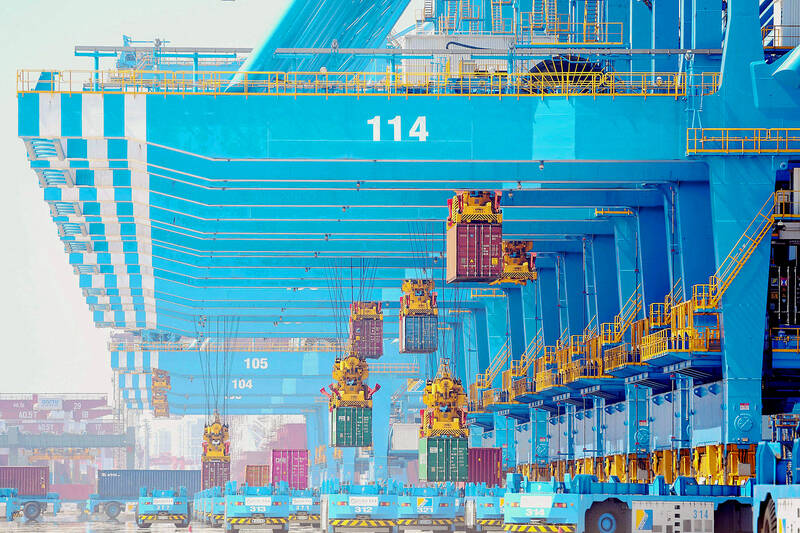China’s export growth slowed significantly last month, customs authorities said yesterday, as economic uncertainty is exacerbated by strict COVID-19 lockdowns across the nation.
The weakness in trade comes as global demand for Chinese products weakens with energy prices soaring and the US facing the threat of recession.
At the same time the domestic property sector — which accounts for about one-quarter of the world’s second-largest economy — continues to struggle, with firms staggering under vast amounts of debt.

Photo: AFP
Overseas shipments in US dollar terms increased 7.1 percent year-on-year, the slowest pace since April when a lockdown in Shanghai disrupted shipping and far weaker than economists had predicted, China’s General Administration of Customs said, while imports were up only 0.3 percent, leaving a trade surplus of US$79.4 billion last month.
“The global economy is slowing down, particular with the troubles of what’s happening in Europe, so double-digit exports growth in the past is not sustainable,” Pinpoint Asset Management Ltd (保銀私募基金管理) chief economist Zhang Zhiwei (張智威) said.
Going forward, “single-digit export growth is more likely,” he said.
Sporadic COVID-19 lockdowns around China have dampened consumer enthusiasm and business confidence, while searing temperatures across large parts of the country this summer prompted power rationing for factories.
While officials have announced a range of measures aimed at bolstering the economy, commentators said that there would not likely be any concerted recovery until the tough COVID-19 measures are removed for good.
“As rising energy prices and monetary policy tightening hit US and Western European households, demand for Chinese manufacturing exports is cooling,” S&P Global Market Intelligence Asia-Pacific chief economist Rajiv Biswas said.
Biswas said he expected these factors to continue dampening Chinese exports for the rest of the year, while the country faces “continued weak domestic demand due to the ongoing impact of pandemic-related restrictive measures on consumer spending, as well as the residential construction slowdown.”
Chinese exports to the US declined 3.8 percent last month from a year earlier, the first contraction since May 2020.
Exports to the EU held up better, recording 11.1 percent growth, as China is supplying more energy-intensive goods like aluminum, which has become more costly to produce in Europe. Even so, the increase was still less than half the pace recorded the previous month.
Chinese exports to Russia surged 26.5 percent year-on-year, as Chinese brands filled a gap left by departing Western companies.
Exports to Taiwan contracted for the first time since January 2020, as China halted some trade in retaliation to the visit of US House of Representatives Speaker Nancy Pelosi.
The latest figures “merely serve to underscore how weak domestic demand still is, and how far away that end of year GDP target of 5.5 percent is,” CMC Markets chief market analyst Michael Hewson said.
Net exports accounted for about one-fifth of China’s GDP growth last year. Economists are predicting GDP would expand just 3.5 percent this year.
A smaller trade surplus going forward would also weigh on the currency, which has slumped this year and is close to breaching 7 yuan to the US dollar. The People’s Bank of China has taken several steps recently to slow the yuan’s depreciation, and yesterday set its reference rate for the currency at the strongest bias on record.
Additional reporting by Bloomberg

SEEKING CLARITY: Washington should not adopt measures that create uncertainties for ‘existing semiconductor investments,’ TSMC said referring to its US$165 billion in the US Taiwan Semiconductor Manufacturing Co (TSMC, 台積電) told the US that any future tariffs on Taiwanese semiconductors could reduce demand for chips and derail its pledge to increase its investment in Arizona. “New import restrictions could jeopardize current US leadership in the competitive technology industry and create uncertainties for many committed semiconductor capital projects in the US, including TSMC Arizona’s significant investment plan in Phoenix,” the chipmaker wrote in a letter to the US Department of Commerce. TSMC issued the warning in response to a solicitation for comments by the department on a possible tariff on semiconductor imports by US President Donald Trump’s

The government has launched a three-pronged strategy to attract local and international talent, aiming to position Taiwan as a new global hub following Nvidia Corp’s announcement that it has chosen Taipei as the site of its Taiwan headquarters. Nvidia cofounder and CEO Jensen Huang (黃仁勳) on Monday last week announced during his keynote speech at the Computex trade show in Taipei that the Nvidia Constellation, the company’s planned Taiwan headquarters, would be located in the Beitou-Shilin Technology Park (北投士林科技園區) in Taipei. Huang’s decision to establish a base in Taiwan is “primarily due to Taiwan’s talent pool and its strength in the semiconductor

An earnings report from semiconductor giant and artificial intelligence (AI) bellwether Nvidia Corp takes center stage for Wall Street this week, as stocks hit a speed bump of worries over US federal deficits driving up Treasury yields. US equities pulled back last week after a torrid rally, as investors turned their attention to tax and spending legislation poised to swell the US government’s US$36 trillion in debt. Long-dated US Treasury yields rose amid the fiscal worries, with the 30-year yield topping 5 percent and hitting its highest level since late 2023. Stocks were dealt another blow on Friday when US President Donald

UNCERTAINTY: Investors remain worried that trade negotiations with Washington could go poorly, given Trump’s inconsistency on tariffs in his second term, experts said The consumer confidence index this month fell for a ninth consecutive month to its lowest level in 13 months, as global trade uncertainties and tariff risks cloud Taiwan’s economic outlook, a survey released yesterday by National Central University found. The biggest decline came from the timing for stock investments, which plunged 11.82 points to 26.82, underscoring bleak investor confidence, it said. “Although the TAIEX reclaimed the 21,000-point mark after the US and China agreed to bury the hatchet for 90 days, investors remain worried that the situation would turn sour later,” said Dachrahn Wu (吳大任), director of the university’s Research Center for